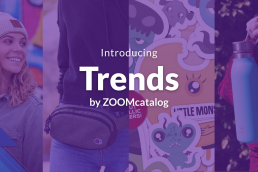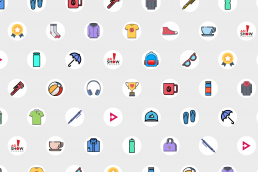Digital Catalogs vs. Print Catalogs
Did you know that the product catalog is over a century old? That’s right, Richard Sears, you know the guy who started the billion-dollar department store, shipped out the first product catalog in 1893 called the Book of Bargains: A Money Saver For Everyone.
The first edition wasn’t filled with much, just a few watches and pieces of jewelry, but it quickly exploded, flaunting sporting goods, sewing machines, firearms, baby carriages, and even full-sized buggies over the following years.
If you were wondering what the catalog looked like back then, take a peek at the cover of their 1897 Sears Roebuck & Co. catalog that featured a slew of diverse items.
We’re all about looking back to move forward. As a brand that focuses on delivering enhanced experiences for promotional product suppliers and distributors, we know the importance of the printed catalog and appreciate its rich history.
That being said, we also understand the value of change, which we’ve all experienced plenty of in 2020. Our industry has been forced to adapt to a new market that is driven by online interactions and exchanges. Virtual sales pitches are becoming more popular and buyers are exploring new ways to get their hands on promotional products.
Suppliers like you are coming to terms with a major business decision: continue paying for print or jump into a new digital catalog.
It’s a decision we’ve helped a lot of suppliers make and we want to help you do the same. That’s why we’ve broken down everything you need to compare the value of digital catalogs to traditional print.
Let’s talk about digital vs print catalogs…
In order to make a fair comparison, we’ve fleshed out the essentials for a successful catalog, which include cost, capabilities, reporting, and updating. Each one of these items plays an important role in how you determine the form of your catalog.
Here’s what they look like:
| Digital | |
| Static – cannot update pricing or products | Flexible – can easily update pricing and products. |
| Expensive to print | Inexpensive to create |
| Shipping charges | No distribution charges |
| Track shipping | Track opens, usage, distribution |
| Limited distribution — USPS/FedEx | Infinite distribution — email, social media, website, content, etc. |
| Limited Accessibility — must be on hand | Unlimited Accessibility- can access 24/7, on any device |
| More images = More pages = more cost per page | No additional cost for larger imagery |
| Limited Content | Dynamic Content such as video, links and calls to action |
| Not customizable | Unlimited customization – easily add distributor logo/contact info |
A Breakdown of Digital vs. Print Catalogs
Cost
You’ll have photography, design, and copywriting costs whether you choose digital or print. These costs are the buy in for creating a catalog of any type.
Where suppliers will see a change in cost is the medium in which they choose. For those going the print route, there are production and shipping costs that range greatly depending on what you print, where you’re sending it, and how fast you want it there.
For example purposes, here’s a quick cost breakdown of what it takes for a mid-size supplier to print two seasonal catalogs.
- 18,000 catalogs (Spring) / 18,000 catalogs (Winter)
- $1.32 / per catalog (a low estimate for printing and shipping)
- $23,760.00 / per season
- $47,520.00 / annually
Bear in mind that print catalogs also run the risk of misprints and mistakes. Once you confirm that order, there is no going back, and if you have a mistake inside of it, you’re stuck for the entire season.
Unlike print, a digital catalog can be constantly updated and adjusted for mistakes or new products. Similarly, digital catalogs have infinite distribution capabilities courtesy of the internet and ZOOMcatalog’s network. Suppliers have the opportunity to reach distributors and end users that would otherwise never be exposed to their products.
Here’s a cost breakdown of using a digital catalog from ZOOMcatalog.
- $1,300 / annually for 2 standard ZOOMcatalogs.
- $2,100 / annually for 2 ZOOMcustom catalogs
- Unlimited quantity and unlimited distribution.
While a print catalog sits on office desks and coffee tables, the digital catalog can go anywhere and be viewed by anyone. With the help of the industry’s hub for supplier catalogs, digital catalogs on ZOOMcatalog can extend their reach far beyond the mailbox, saving you money while dramatically increasing exposure.
Capabilities
The first and most obvious is the reach you can achieve. With a print catalog, you are limited by the expense and time required to ship catalogs to distributors. Once it arrives in its location, it’s distribution is out of your hands and left up to the recipient.
On the other hand, a digital catalog can be distributed across every platform—immediately. From your emails to blog posts, social media to websites, you and your distributors can instantly spread your products globally.
In the same vein, going digital allows you to extend far beyond the one mailbox of your recipient. With a print catalog, your share-to-reach ratio is 1/1—1 catalog = 1 person. Meanwhile, one digital catalog can be shared with thousands, if not millions across all the platforms at your disposal.
Sounds pretty efficient, right?
If that weren’t enough, digital catalogs also have one more tool in their arsenal that print will never live up to–dynamic content.
People want to see what they’re buying in action. Nobody likes receiving their new promo products, only for them to not work as expected. Dynamic video allows you to show proof that the products you’re featuring are not only legitimate but also high-quality.
Check out this video enabled ZOOMcatalog from Vantage Apparel’s Climate Collection to see how even a 5-second clip can enhance the digital catalog experience.
If it’s not obvious, video is becoming more popular in the promotional product space, and having the ability to leverage it in your catalog can be a massive advantage for your marketing team.
Reporting
Some suppliers overlook the value of data. Just like any other marketing tool, your catalog is an investment—you put money in, to get money back. Understanding the effectiveness of that investment is imperative to finding success in your business.
That being said, it’s not easy to measure ROI for your printed catalog. Sure you’ll get a shipping confirmation and maybe a phone inquiry, but it’s hard to take action and make marketing decisions off a shipping confirmation.
When you go digital on ZOOMcatalog, you can access live data on how your catalogs and flyers are performing. Get a glance into who’s accessing and customizing your catalogs, so that you can get a better understanding of what that distributor is looking for and how they operate.
The distinct advantage here is that you collect more detailed and accurate data that can inform your future marketing efforts and catalogs.
Updates
What’s your current print catalog schedule look like? Are you releasing a new one every month? Three months? Year? The challenge with print catalogs is that their shelf life is limited.
Like a timely news piece, they only stay relevant for so long. Then you’re left with the less-exciting and out-dated catalog.
A digital catalog has no shelf life and never loses its value because it can constantly be updated. No paying extra for a reprint, no re-designs, just a few additional digital pages, and you’re on your way like nothing ever changed.
Mistakes are also a reality. You do everything possible to avoid them, but it’s inevitable a few will sneak through in a robust catalog. With print, there’s nothing you can do but cringe every time you hit that page. With digital, you can correct the issue and forget it ever happened.
The major key here is that you have the ability to make changes directly at your fingertips and the cost to make it happen is nothing—all it requires is a little bit of your time.
Know your catalog needs.
Before you can jump into a new catalog, you need to know what you’re looking for. As a supplier, you have specific requirements and needs for your catalog which can determine the form that it takes.
Evaluate the most essential and necessary parts of your catalog. Would it be enhanced and more effective if it was digital compared to print? Would your customers prefer to have 24/7 access to your catalog? Maybe you need a print/digital hybrid approach?
These are all questions you must ask in order to determine the best form for your catalog.
If you’re ready to make the switch and start crafting killer catalogs that distributors want to sell from, check out our Complete Guide to Going Digital, or shoot us a message to schedule a digital consultation with one of our experts.
How The Coronavirus Will Shape Buyer Behavior – 3 Predictions
Let’s take a step back and look at how the coronavirus will influence businesses and consumers.
How Dunkin’ Donuts, MAGA Hats, and Marathon Runners Are Driving Promotional Product Sales
I trained for over a year, fought through injuries, and suffered for 4 hours to finish my first marathon. What am I looking for after I…
Introducing Trends by ZOOMcatalog
Each month we’re going to make sure you have all the best industry information to keep your team up to date, and your bottom line……
ZOOMcatalog attends the 2019 PPAI North American Leadership Conference and Tech Summit in Dallas
Noleen and Bryony Zasman, co-founders of ZOOMcatalog, attended the PPAI NALC and Tech Summit in Dallas.
ASI Chicago 2019 – Stand Out Products
Following the ZOOMcatalog teams visit to ASI Chicago 2019, Find out about the newest and stand out products from some of your favourite…
PPAI 2019 Women’s Leadership Conference
ZOOMcatalog co-founders Donna Lomazini and Noleen Zasman were privileged to attend the 2019 PPAI Women's Leadership Conference in New…






